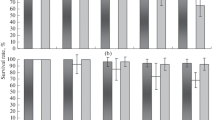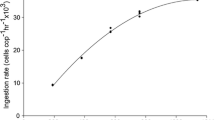Abstract
Acartia tonsa Dana longevity and egg production data were studied over a 4-year period under standardized culture conditions. Egg-laying patterns and daily rates were evaluated as bioassay tools for measuring the nutritional value of various copepod foods, as well as assessing other aspects of environmental quality. Altogether, 337 females were observed in various aspects of this work. Experiments were performed with newly matured females in loosely covered crystallizing dishes. Fresh water and a standard concentration of algae were supplied daily, and a running daily tally was kept of the eggs produced. The effects of male copepods on egg production were analyzed. Males were either removed after the first eggs were observed or they remained with the female throughout her life span. Daily egg-laying rates of this latter group of females appeared to be more stable, but abnormal embryo development occurred if the males were not removed after fertilization. Likewise, the results of females which were not mated were studied. Life spans were shorter and egg production rates were lower than those of contemporary mated females. Unmated females were subjectively observed to be less active than their mated counterparts. The effects of continuous and temporary starvation on egg-laying were also observed. Under both normal and starved conditions, males appeared to have shorter life spans than either mated or unmated females. During starvation there were no real differences between the life spans or egg productions of mated or unmated females. Non-nutritional particulate matter was evaluated as a food source. It was ingested by the females, but did nothing to prolong the egg-laying period. Finally, the three algal components of the standard ration were evaluated. Females produced equally well with a mixed diet or with Thalassiosira pseudonana (100 μm3) or Chroomonas salina (140 μm3), the two larger species of this diet, but when Isochrysis galbana (40 μm3) was fed, females reacted as if in a starved situation.
Similar content being viewed by others
Literature Cited
Bogorov, B.J.: Sex ratio in marine copepods(On the problem of evaluation of plankton production). Dokl. (Proc.) Acad. Sci. U.S.S.R. 23, 706–709 (1939)
Conover, R.J.: Reproductive cycle, early development, and fecundity in laboratory populations of the copepod Calanus hyperboreus.Crustaceana 13, 61–72 (1967)
Corkett, C.J.: Technique for rearing marine calanoid copepods in laboratory conditions. Nature, Lond. 216, 58–59 (1967)
— and I.A. McLaren: Egg production and oil storage by the copepod Pseudocalanus in the laboratory. J. exp. mar. Biol. Ecol. 3, 90–105 (1969)
Fulton, J.: Some aspects of the life history of Calanus plumchrus in the Strait of Georgia. J. Fish. Res. Bd Can., 30, 811–815 (1973)
Guillard, R.R.L. and J.H. Ryther: Studies of marine planktonic diatoms. I. Cyclotella nana Hustedt and Detonula confervacea (Cleve) Gran. Can. J. Microbiol. 8, 229–239 (1962)
Heinle, D.R.: Culture of calanoid copepods in synthetic sea water. J. Fish. Res. Bd Can. 26, 150–153 (1969)
Jacobs, J.: Laboratory cultivation of the marine copepod Pseudodiaptomus coronatus Williams. Limnol. Oceanogr. 6, 443–446 (1961)
Kester, D.R., I.W. Duedall, D.N. Connors and R.M. Pytkowicz: Preparation of artificial seawater. Limnol. Oceanogr. 12, 176–179 (1967)
Lee, R.F.: Lipid composition of the copepod Calanus hyperboreus from the Arctic Ocean. Changes with depth and season. Mar. Biol. 26, 313–318 (1974)
—, J. Hirota and A.M. Barnett: Distribution and importance of was esters in marine copepods and other zooplankton. Deep-Sea Res. 18, 1147–1165 (1971a)
—,J.C. Nevenzel and G.-A. Paffenhöfer: Importance of wax esters and other lipids in the marine food chain: phytoplankton and copepods.Mar. Biol. 9, 99–108 (1971b)
Marshall, S.M. and A.P. Orr: On the biology of Calanus finmarchicus. VII: Factors affecting egg production. J. mar. biol. Ass. U.K. 30, 527–547 (1952)
—: Calanus finmarchicus: egg production and egg development in Tromsø Sound in spring. Acta boreal. (A) 5, 1–21 (1953)
—: The biology of a marine copepod, 195 pp. New York: Springer-Verlag 1972
Mullin, M.M. and E.R. Brooks: Laboratory culture, growth rate, and feeding behavior of a planktonic marine copepod. Limnol. Ocenogr. 12, 657–666 (1967)
Nassagne, A.: Influence of food organisms on the development and culture of pelagic copepods. Helgoländer wiss. Meeresunters. 20, 333–345 (1970)
Paffenhöfer, G.A.: Cultivation of Calanus helgolandicus under controlled conditions. Helgoländer wiss. Meeresunters. 20, 346–359 (1970)
Parrish, K.K. andR.A. Carr: Transport of mercury through a laboratory two-level marine food chain. Mar. Pollut. Bull. 7, 90–91 (1976)
Raymont, J.E.G. and G. Gross: XX. — On the feeding and breeding of Calanus finmarchicus under laboratory conditions. Proc. R. Soc. Edinb. (Sect. B) 61, 267–287 (1942)
Wallace, G.T., Jr. and D.F. Wilson: Foam separation as a tool in chemical oceanography. N.R.L. Rep. 6958, 1–17 (1969)
Wilson, D.F. and K.K. Parrish: Remating in a planktonic marine calanoid copepod.Mar. Biol. 9, 202–204 (1971)
Zillioux, E.J. and D.F. Wilson: Culture of a planktonic calanoid copepod through multiple generations. Science, N.Y. 151, 996–998 (1966)
Author information
Authors and Affiliations
Additional information
Communicated by M.R. Tripp, Newark
Rights and permissions
About this article
Cite this article
Parrish, K.K., Wilson, D.F. Fecundity studies on Acartia tonsa (Copepoda: Calanoida) in standardized culture. Mar. Biol. 46, 65–81 (1978). https://doi.org/10.1007/BF00393822
Accepted:
Issue Date:
DOI: https://doi.org/10.1007/BF00393822




